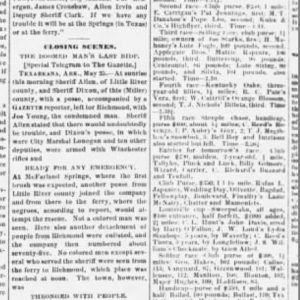calsfoundation@cals.org
Joseph Young (Execution of)
On May 25, 1883, a young African American man named Joseph Young was executed in Little River County for an alleged assault on a white woman named Chism. No information is available on the Chism family, but in the 1880 federal census for Little River County, Joseph Young was living with his parents, farmer Alfred Young and his wife, Caroline, and his father was working as a ferryman. This census lists him as being fourteen, which would make his age seventeen at the time of his execution.
The crime itself was described in a May 26, 1883, article in the Arkansas Gazette. In November 1882, a “comparatively poor” family named Chism arrived in Little River County with all their possessions. Members of the family included a man and his wife, described as “a rustic beauty,” and several small children. They put up a tent near a stream, close to a ferry operated by Alfred Young. Mr. Chism found work hauling goods in the area. He was gone during the day but returned to the family at night. According to reports, one day in December Alfred Young’s son Joe—described as “coal black, low-browed” with a “heavy chin, wide nose and thick lips…a horrible-looking object, resembling a beast more than a human being”—came to the tent looking for Mr. Chism. Mrs. Chism said he would be back that evening, and Joe Young offered to cut some wood for her. He did so and left, and after the last ferry was gone, knowing that Chism would not make it home that night, he returned to the tent and “cruelly, wickedly outraged the woman.” She fainted, and when she awakened, he was gone. She ran to the nearest house for help, and the residents took chase. Young was captured, tried, convicted, and sentenced to be executed at Richmond (Little River County) on May 25, 1883.
Little River County having no prison, he was sent to jail in Texarkana (Miller County) to await execution. A reporter from the Gazette visited Young before he was transferred back to Little River County and said that Young had nothing to say except that he wanted to see his father, brothers, uncles, and cousins. At first, he refused to admit his guilt, but when told that he might not be able to say anything before his execution, he allegedly told the reporter, “I don’t know how I come to do it, but I am guilty; I did wrong, and I am sorry for it. I found the woman asleep in the tent at night, with her babies. No one told me to do it. Ignorance caused me to do it.” The reporter concluded that “his confession was full and complete.”
According to another article published in the Gazette that same day, Little River County Sheriff J. R. Allen was in charge of Young’s transfer back to Richmond. Threats having been made by local African Americans, including his father Alfred Young (described as a “influential negro”), Allen planned carefully for the transfer. Young was shackled with an iron collar, and Sheriff C. E. Dixon of Miller County and several well-armed men accompanied Allen and Young on the journey. They were later joined by a posse from Little River County and a group of people from Richmond, swelling the ranks to seventy-five. When they arrived in Richmond, they were met by a large crowd, “many of whom were colored men and women.” Most of these people sympathized with Young, and “the excitement was at fever heat.” In response, armed white men patrolled the town. The guards took Young to the blacksmith to have the collar removed, and while he was there someone fired a shot. Pandemonium ensued, with many African Americans fleeing to the woods.
Young was then taken to the scaffold, where he was accompanied by a minister, several members of law enforcement, and two relatives. After a reading from the Bible and a hymn, the scene was photographed. Young spoke, uttering “an incoherent run of words almost without sense.” He was then hooded, and stood “trembling like an aspen, and groaning with every breath.” The African Americans in the crowd “echoed his every groan,” and when he was hanged, they “broke into loud weeping and louder groaning.” The rope, which was apparently stiff, did not break Young’s neck, but four doctors later reportedly pronounced him dead.
Oddly, almost a month later, the Southern Herald, published in Liberty, Mississippi, reported that Young had “been restored to life and is yet living — His friends noticed signs of life when he was cut down from the gallows, and by their efforts he has been restored.”
For additional information:
“Closing Scenes.” Arkansas Gazette, May 26, 1883, p. 1.
“Strangled to Death.” Arkansas Gazette, May 26, 1883, p. 1.
Untitled. Southern Herald (Liberty, Mississippi), June 23, 1883, p. 2.
Nancy Snell Griffith
Davidson, North Carolina
 Law
Law Post-Reconstruction through the Gilded Age, 1875 through 1900
Post-Reconstruction through the Gilded Age, 1875 through 1900 Young Execution Story
Young Execution Story 



Comments
No comments on this entry yet.